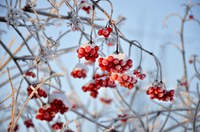Dakota Gardener: Battling birds for fruits
(Click an image below to view a high-resolution image that can be downloaded)
By Tom Kalb, horticulturist
NDSU Extension
I love my cherry shrub—but so do the birds.
As soon as the fruits begin to redden, every bird in the neighborhood flocks to the shrub. The birds aren’t picky about the sweetness of the cherries, and half of the fruits are eaten before they ripen.
Once the fruits ripen, the ultimate battle begins.
I chase the birds away and harvest as many of the remaining fruits as I can. The birds fight back, but I act like the fiercest scarecrow, screaming and waving my hands toward them. After my bucket is full, I surrender and let the birds eat the rest of the fruits.
Juneberry is another great shrub. As soon as the berries start to turn blue, the birds attack the delicious fruits. When I lived in Wisconsin, we never thought about battling birds for the fruits. We simply accepted our fate and let the birds eat them.
North Dakotans are different. We fight for our food. In North Dakota, no bird gets a juneberry until we say so.
It’s easy to recommend growing delicious cherries and juneberries, but some of the greatest shrubs for landscapes produce disgusting fruits.
Start with cranberrybush viburnum. The 10-foot shrub is loaded with white flowers in spring and glossy green foliage all summer. Then comes autumn when something remarkable happens.
Its clusters of fruits begin to redden. Birds are attracted to the bright berries, but the fruits taste absolutely terrible. The birds leave the fruits untouched all winter long.
This makes the cranberrybush viburnum one of the finest shrubs in winter.
While the rest of the landscape is drab and lifeless, the scarlet berries sparkle in the winter sun. With a blanket of white snow in the background, the impact of this shrub is amazing.
In early spring, when no other food is available, birds will eat the fermented berries. The drunken birds fly high and get high at the same time, just in time for the breeding season to begin.
Another terrible tasting fruit is chokeberry. That’s not a very appealing name, but if you ever eat a chokeberry this time of year you will understand how the fruit got its name. Gag me!
Although its fruits in autumn are disgusting, chokeberry has great features for a landscape plant. It thrives in our prairie soil, tolerates drought and is pest free. The plant has white blossoms in spring, deep-green foliage in summer, and its golden-orange leaves in autumn are truly spectacular.
Birds won’t touch the dark blue, disgusting chokeberries for months, making this another showy plant for fall and winter.
If you are interested (and have plenty of sugar), the fruits of cranberrybush viburnum and chokeberry can be processed into flavorful jams and juices.
When looking for shrubs in your landscape, consider growing these delicious and disgusting fruits. Both you and the birds may enjoy their flavors and beauty!
For more information about gardening, contact your local NDSU Extension agent. Find the Extension office for your county at www.ndsu.edu/agriculture/extension/county-extension-offices.
NDSU Agriculture Communication – Sept. 27, 2023
Source: Tom Kalb, 701-877-2585, tom.kalb@ndsu.edu
Editor: Kelli Anderson, 701-231-7881, kelli.c.anderson@ndsu.edu




